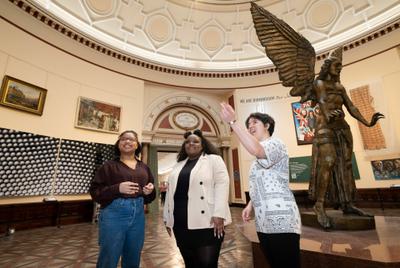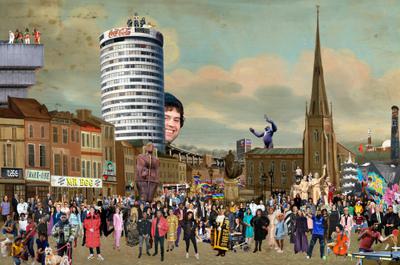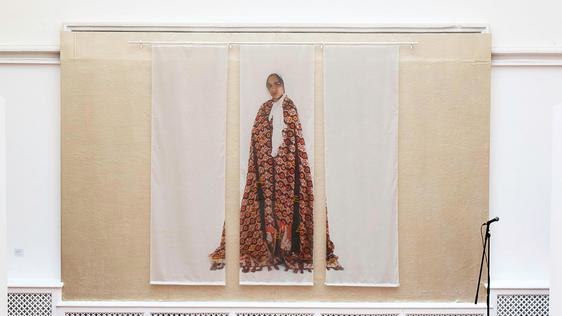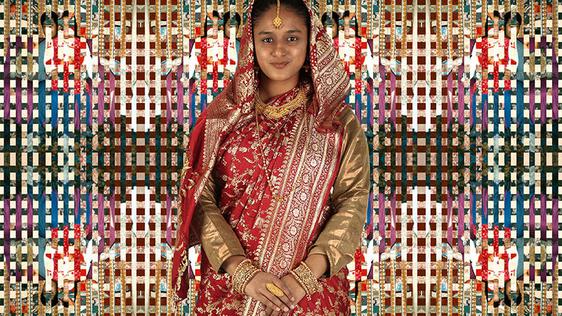News Story
The We Are Birmingham exhibition at Birmingham Museum and Art Gallery (BMAG) has radically transformed its iconic Round Room and has been co-curated by museum staff and six young women of Birmingham in order to challenge the stories and selection of artworks found within established museum spaces.
Created from the Birmingham Museums Trust (BMT) collection the exhibition is part of a four-year programme with We Don’t Settle, which provides opportunities for young people of colour to change the narratives in the heritage sector and a platform to share stories that are historically neglected.

We Don’t Settle also addresses representation and complex histories within the heritage sector, to better understand how Birmingham celebrates and reflects on itself in an innovative and contemporary way.
This has meant that the We Are Birmingham exhibition reflects the historic and contemporary diversity of Birmingham by presenting an eclectic mix of art, photography and objects and new interpretations as a celebration of an evolving city. Opened in April, as a key component of the museum’s partial reopening during essential maintenance, the exhibition also forms part of the Birmingham 2022 Festival and is funded by the Commonwealth Games.
We Don’t Settle has worked in partnership with BMT since 2018 – completing curatorial and reimagining projects at Soho House and Aston Hall – as part of the Kick the Dust programme, funded through the National Lottery Heritage Fund.
“We are Birmingham is an amazing example of how an iconic heritage institution can transform the narrative,” says Sipho Ndlovu, Programmes Producer at We Don’t Settle.
Among the exhibition’s highlights are Bennie’s Babbies by Cold War Steve – which itself showcases diverse Brummie personalities – The Wall by Anwar Shezma and The Past is Now by Sarah Maple, as well as photographs by Vanley Burke and Pogus Caesar.

We Don’t Settle’s mission is for young people who are minoritised by society, systems and structures, to feel empowered and encouraged not to settle. The Birmingham-based organisation says that We Are Birmingham is evidence of how a long-lasting partnership with a large heritage organisation, such as BMT, can create a platform for young People of Colour to take the lead in transforming heritage spaces.
“Our aim was for the project to become a best practice model for how heritage institutions can work in co-creation with Young People of Colour to change the stories they tell, while young people involved develop new skills and a richer understanding of working within and with a large heritage organisation, to set them up to pursue a career in the heritage and cultural sector,” says Ndlovu.
“The fact that the activators are still engaged with We Don’t Settle and BMT – working on different events, as freelancers on other BMT projects, and other capacities – speaks volumes of the success of We are Birmingham. This is echoed by the positive feedback we have received from the audiences.
“For our organisation, We Are Birmingham gave the opportunity to pilot a new way of working with a large heritage institution in platforming untold stories and provided a lot of insight about how our practices can be further developed.”

Ndlovu says that choosing the activators wasn’t just about picking people who would take ownership of this opportunity but also group dynamics.
Before deciding who the activators would be, they conducted an online recruitment campaign, an accessible recruitment practice, followed by interviews.
“The activators that we picked – all with their own unique passions and experiences – didn’t disappoint and were a prime example of what teamwork is and gave immense meaning to the words dream team!
“The interviews showed the passion, skills and drive of the amazing Women of Colour that worked on the exhibition, to bring the stories of communities that make Birmingham one of the most diverse cities in the UK.
“We continue to be inspired by their engagement in the project and results on the wider West Midlands community. While visiting we may have eavesdropped into some overwhelmingly positive responses from onlookers and visitors to the space.”

The We Don’t Settle activators are Lauren Vidal, Justine Luaba, Kiran Samra, Masharah Powel, Gabriella Songui, and Olivia Agbe.
Samra says: “With the build-up to the partial reopening of the museum and the launch of the Commonwealth Games it has been really exciting to see the project go on public view at such an incredible moment in history.
“It has been a process of reflection, conversation and learning and we are excited to be sharing some incredible stories and artworks with the public.”
The We Don’t Settle team worked with the museum team of Emalee Beddoes, Curator (Modern & Contemporary Art) and Andy Fowles, Learning Manager.
It was ten years ago since the Round Room was last changed and stylistically it hasn’t changed since the ‘70s when the cream colour was introduced, and it was a much sparser hang.
This latest reimagining of the Round Room has been in the making since 2018 when the museum staff were sharing ideas for what each gallery would be like during the museum’s redevelopment.

Beddoes says that because the Round Room is seen as defining the museum, it is why it was such an important space to have for this project and has become instrumental to the process of redefining the museum.
At the time Beddoes had given a talk to We Don’t Settle while working the exhibition Women, Power and Protest, where she broached the subject of consulting with some of the staff and activators about this new project in the Round Room.
“I didn’t feel like it could be done properly in house with our staff and I wanted to widen the ideas. And they were so keen that it became a whole project that, instead of loosely advising me, it turned it into a development and co-production project.”
We Are Birmingham was run as a curatorial project with museum staff but also as a development project, so the activators also worked with the BMT team to explore different elements of museum work. Initially they worked with Andy Fowles and completed some consultation.
They then had fact-finding activities and created a curatorial concept from that. One of the activities was a public consultation in Centenary Square where they quizzed members of the public about what the city means to them and created a huge document with key words and themes.
These were gathered together by Beddoes who proposed hundreds of objects from the collection and put them in a Pinterest Board so that the activators could visualise them.
The activators were told what the artworks were and their history, and they made a long list of what spoke to them and also recognised the themes that came out of the consultation. Then once they had a workable list of about 70 artworks, they grouped the objects together using the themes from the public and how they were tying in with Birmingham’s story.
“So, that’s how we came up with the themes Our City, Our Journey, Our Joy,” says Beddoes. “We wanted to be critical so there’s pieces about Cadbury’s that explores, not necessarily its relationship to slavery, but how industrial and globalised trade was inextricably linked with slavery.”

There are various pieces, for example, that explore the difficult racialized historic subjects including a portrait of John Akomfrah with the interpretation delving into the Handsworth riots of 1981.
“Lots of the stories in the exhibition are from uncomfortable, painful, difficult histories but being We Are Birmingham that’s just one part of the whole story. There’s a section called Our Joy and we wanted to see black joy and what’s so great about having a multicultural city is you can draw out food culture, humour and music.
“I feel like the final display is firmly in the activators’ voice and during the project it was like I was working for the co-curators and they were my managers. They were the creative directors, and my job was to find the objects and make them work within the space.”
There were no restrictions put on the activators and the only restrictions were largely practical, for example, one object they wanted to display – the famous HP sign – couldn’t be hung securely in the Round Room.
“We don’t really have filters on what we can and cannot say about the past. What we felt was important is that we included the historic perspective of Birmingham.
The display shows some of the topographical paintings of Birmingham which represent how Birmingham used to be but the main focus, however, and what the activators have achieved, is to create a visual experience of Birmingham’s identity now.
“There is an association with work about racial politics that it will all be about difficulties and of course we live in a structurally racist society, so that is part of it, but it is also the history of black and Asian communities in Birmingham who share wonderful and joyful experiences and the best things about the city.”
The exhibition has also been pleasantly surprising for what Beddoes calls the ‘traditional audience’. She said she spoke to someone while working on the project who loves the Pre-Raphaelites and the Arts and Craft movement and they read the press release and did not think they were going to like it.
“They thought it was a travesty to take down the beautiful paintings but when they visited, they loved it because it is historical, it celebrates the collection, and it is joyful and celebratory.”
Closure of Birmingham Museum and Art Gallery
We are Birmingham can be seen until Sunday 13 November 2022. Birmingham Museum and Art Gallery closes for planned maintenance work.


